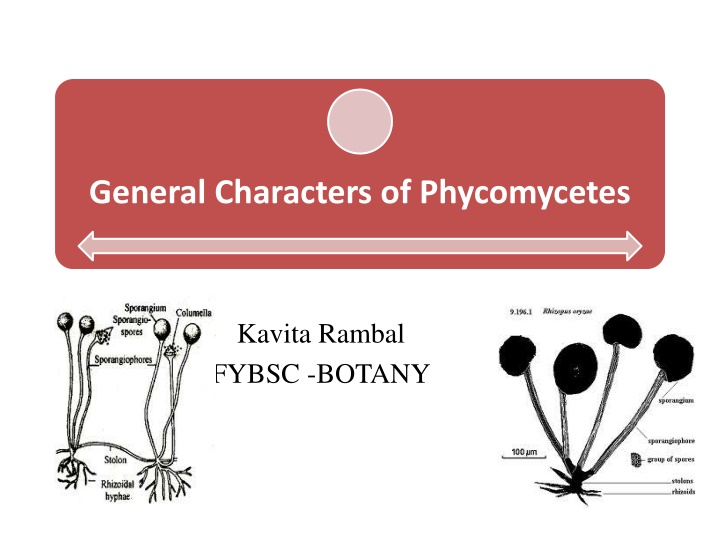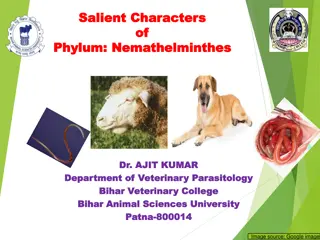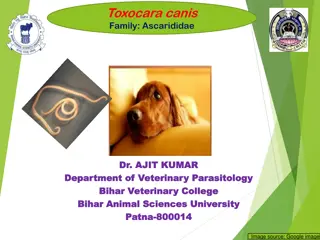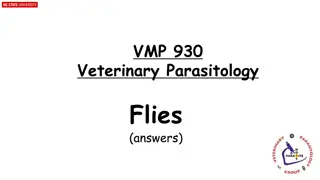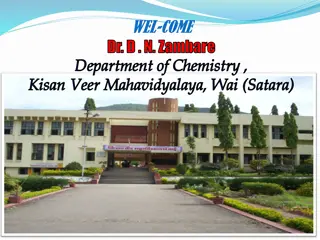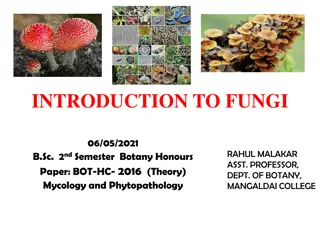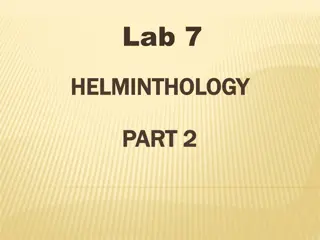General Characteristics of Phycomycetes: An Overview
Phycomycetes constitute an important class of parasitic or saprophytic fungi, exhibiting characteristics ranging from undifferentiated masses to well-developed mycelium. They reproduce sexually and asexually, utilizing spores, conidia, and chlamydospores. The thallus structure varies, with some having a one-celled thallus with a cell wall, while others show branched hair-like rhizoidal systems. Understanding their reproductive mechanisms and thallus structure is crucial in studying these alga-like fungi.
Download Presentation

Please find below an Image/Link to download the presentation.
The content on the website is provided AS IS for your information and personal use only. It may not be sold, licensed, or shared on other websites without obtaining consent from the author.If you encounter any issues during the download, it is possible that the publisher has removed the file from their server.
You are allowed to download the files provided on this website for personal or commercial use, subject to the condition that they are used lawfully. All files are the property of their respective owners.
The content on the website is provided AS IS for your information and personal use only. It may not be sold, licensed, or shared on other websites without obtaining consent from the author.
E N D
Presentation Transcript
General Characters of Phycomycetes Kavita Rambal FYBSC -BOTANY
Fungi Classes Fungi are usually classified according to biological taxonomy based upon the type of hypha, spore, and reproduction. There are four classes of fungi, whose characteristics are a. Class Phycomycetes. The algal fungi: bread molds and leaf molds b. Class Ascomycetes. The sac fungi: yeasts, mildews, and cheese molds. c. Class Basidiomycetes. Mushrooms, toadstools, rusts, and smuts. d. Class Deuteromyceters. Fungi imperfecti: a heterogeneous collection of fungi without sexual reproduction. Most of the pathogens encountered in medical mycology belong to this class.
PHYCOMYCETES Phycomycetes is derived from two Greek words viz; Phykos : ALGA and Mycetae :Mushroom (Fungi).Primitive phycomycetes are predominantly aquatic,higher forms show dependence on moisture and are either saprophytic or parasitic.
PHYCOMYCETES A large, important class of parasitic or saprophytic fungi, alga like fungi. The plant body ranges from an undifferentiated mass of protoplasm to a well-developed and much-branched mycelium. Reproduction is mainly sexual, asexual by the formation of conidia or sporangia; but the group shows every form of transition from this method through simple conjugation to perfect sexual reproduction.
Phycomycetes Thallus Structure In very primitive forms the thallus is one celled with or without cell wall. In Olpidium cell wall is absent. Advanced unicellular types show branched hair like rhizoidal system (anchorage).Chytridium. Unicellular forms are holocarpic.Majority have coenocytic,branched and aseptate hyphae.Vegetative & reproductive parts are well differentiated.Hyphae together form a mycelllium. Hyphae give out haustoria.
Phycomycetes Reproduction Phcoymycetes reproduce : 1) Asexually 2) Sexually 3) Vegetatively (Fragmentation)
Asexual Reproduction Asexual reproduction takes place by means of a) Spores (within sporangia on sporangiophores). b)Conidia . c) Chlamydospores. Asexual reproduction occurs by sporangia which contain spores. Depending on the habitat sporangia produce different spores. In terrestrial they produce conidia and in aquatic conditions it produces zoospores. They have two flagella. One of the flagella is smooth and the other one is tinsel type.
Asexual Reproduction The sporangia are developed at the end of the hyphae and are cut off by the formation of septa.The sporangia are of different shapes.(flask,cylindrical,irregularly lobed or rounded. The spores are single celled or aflagellate.Flagellate spores are called zoospores while aflagellate spores are known as aplanospores or sporangiospores. Other aflagellate spores are conidia and chlamydospores.
Asexual Reproduction Zoospores: Zoospores are formed in aquatic Phycomycetes.The zoospores are uniflagellate or biflagellate and naked. The uniflagillate zoospore has one ,whiplash type of flagellum attached at the anterior narrow end. Biflagellate zoospore has two types of flagella one tinsel and the other of whiplash type. Monoplanetism as well as diplanetism is found.
Asexual Reproduction Sporangiospores or aplanospores Formed generally by the terrestrial Phycomycetes e.g,Rhizopus. 1. The spores are thin, nonmotile ,rounded , wind dispersed formed within sporangia. 2. The sporangia are borne on the tips of the erect hyphae called sporangiophores. 3. The sporangiophores may be branched or unbranched.
Asexual Reproduction Conidia These are one celled formed on hyphae called conidiphores.These can be branched or unbranched. On germination in wet conditions produce zoospores but in dry conditions they germinate to form germ tube which develops into mycelium.
Asexual Reproduction Chlamydospores Formed in unfavorable conditions Also called resting spores Intercalary in position Eg: Mucor Oidia These are rounded or oval shaped, thin walled spores They germinate to produce new mycelium
Sexual Reproduction It ranges from Isogamy to Oogamy. Types include: 1. Gametangial Union or Planogametic copulation. 2. Gametangial Contact 3. Gametangial Copulation
Sexual Reproduction Gametangial Union or Planogametic copulation. It is the fusion of two gametes,where one or both aremotile. They may be uniflagellate or biflagellate. The gametes may be similar (isoplanogametic) e.g,Olpidium. The gametes may be dissimilar (anisoplanogametic) e.g, Allomyces One of the gametes is motile (male) called spermatozoid while the female gamete is non-motile and is call egg. Eg: Monoblepharis
Sexual Reproduction Gametangial Contact Gametes are non-motile (aplanogametes). They are never released. The gametangia are highly differentiated. Male Gametangian is called anthredium and female oogonium. Anthredium at the time of fertilization develops fertilization tube which connects oogonium. Through this tube the male gamete passes and unites with egg to form a zygote. Eg: Pythium, Albugo.
Sexual Reproduction Gametangial Copulation The two gametangia unite without the formation of fertilization tube. The walls in between dissolve. The cytoplasm and nuclei merge/unite to form zygospore Eg: Rhizopus
